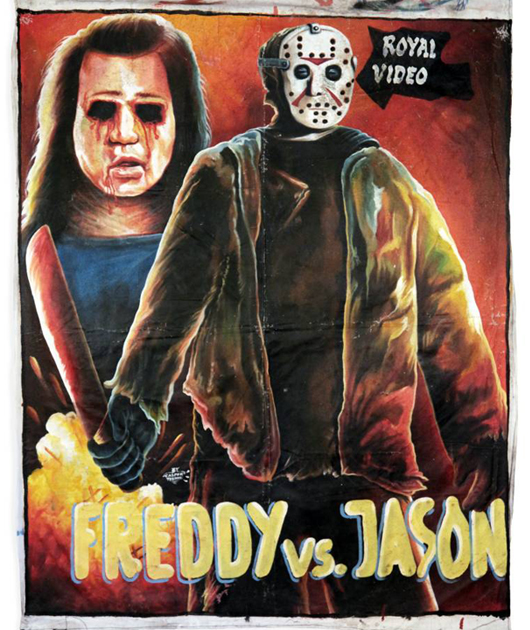Freddy vs Jason African Ghana Posters
Continuing our look at the African Ghana Posters, today we are featuring two posters from the film Freddy vs Jason. For those visitors that are unaware of the history of these posters, a detailed explanation is listed below. After reading about the history of these posters, take a look at the two Freddy vs Jason posters and let us know what you think. One poster has the title to the film backwards, naming it Jason vs Freddy!
In the 1980s video cassette technology made it possible for “mobile cinema” operators in Ghana to travel from town to town and village to village creating temporary cinemas. The touring film group would create a theatre by hooking up a TV and VCR onto a portable generator and playing the films for the people to see.
In order to promote these showings, artists were hired to paint large posters of the films (usually on used canvas flour sacks). The artists were given the artistic freedom to paint the posters as they desired - often adding elements that weren’t in the actual films, or without even having seen the movies. When the posters were finished they were rolled up and taken on the road (note the heavy damages). The “mobile cinema” began to decline in the mid-nineties due to greater availability of television and video; as a result the painted film posters were substituted for less interesting/artistic posters produced on photocopied paper.
The artistic freedom that these artists were given allowed for the creation of some very interesting and sometimes bizarre posters that, as screenwriter Walter Hill wrote, were quite often “more interesting than the films.”


In the 1980s video cassette technology made it possible for “mobile cinema” operators in Ghana to travel from town to town and village to village creating temporary cinemas. The touring film group would create a theatre by hooking up a TV and VCR onto a portable generator and playing the films for the people to see.
In order to promote these showings, artists were hired to paint large posters of the films (usually on used canvas flour sacks). The artists were given the artistic freedom to paint the posters as they desired - often adding elements that weren’t in the actual films, or without even having seen the movies. When the posters were finished they were rolled up and taken on the road (note the heavy damages). The “mobile cinema” began to decline in the mid-nineties due to greater availability of television and video; as a result the painted film posters were substituted for less interesting/artistic posters produced on photocopied paper.
The artistic freedom that these artists were given allowed for the creation of some very interesting and sometimes bizarre posters that, as screenwriter Walter Hill wrote, were quite often “more interesting than the films.”



